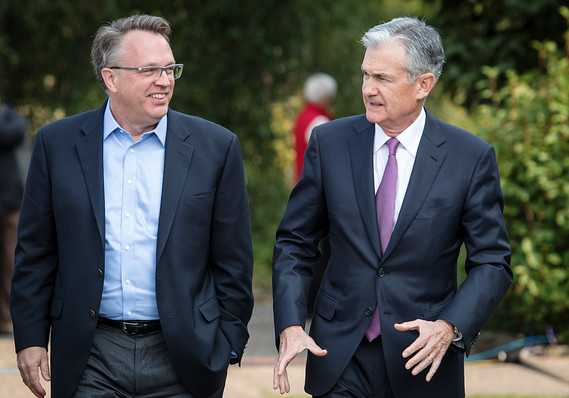 Bloomberg News/Landov
Bloomberg News/Landov
Given that its benchmark interest rate is so close to zero, the most effective strategy for the Federal Reserve is to cut rates at the first sign of trouble, said New York Fed President John Williams on Thursday.
“When you have only so much stimulus at your disposal, it pays to act quickly to lower rates at the first sign of economic distress,” Williams said in a speech at a research conference in New York.
Investors saw Williams’ comments as endorsing a half-point rate cut at the central bank’s next policy meeting on July 30-31.
But a New York Fed spokesman took issue with this characterization and said the talk was theoretical.
“This was an academic speech on 20 years of research. It was not about potential policy actions at the upcoming FOMC meeting,” the spokesman said late Thursday.
In two days of testimony to Congress last week, Fed Chairman Jerome Powell signaled the central bank was prepared to ease monetary policy at the end of the month.
Powell cited slowing economic growth abroad and global trade-policy tensions as two signs of distress that were setting the stage for the Fed to cut rates.
Read: Fed’s Powell says trade worries restraining the economy, hints at interest-rate cuts soon
The Fed’s benchmark rate is now set at between 2.25% and 2.5%. Many other economists have argued the Fed should keep its powder dry with its ammunition so limited.
In his speech, Williams said this “wait-and-see” approach is fine when rates are far away from the so-called “zero lower bound.”
Williams has been a top researcher at the Fed for almost 20 years on the subject of the zero lower bound, when short-term rates can get stuck at zero and go no lower, even if poor economic and market conditions would call for deeply negative rates.
Some countries have experimented with negative rates, but the idea is not popular with the Fed. Rates can’t go deeply negative because households will simply hold their savings as cash rather than pay their banks to hold their deposits.
Williams said a quick rate cut was similar to a vaccination. “It’s better to deal with the short-term pain of a shot than to take the risk that they’ll contract a disease later on,” he said.
Traders in the fed funds futures market boosted their expectations of a half-point rate cut by the Fed following the speech. They now see more than a 50% chance of a big move, up from 34% a day ago.
George Selgin, a monetary policy expert at the Cato Institute, tweeted that the New York Fed’s comments translated into support for a quarter-point cut.
Williams said two other strategies were also seen as successful in his economic models. First, the Fed should keep rates lower for longer when near zero. And the other conclusion is to promise to “make up” for any low inflation during a weak period by allowing inflation to run hotter in good times.
Williams, as New York Fed president, always has a vote on Fed interest-rate decisions. He is seen as a member of Powell’s inner circle of advisers.
His speech came at an important time, right before the blackout period when Fed officials refrain from speech-making to get ready for the late-month policy meeting.
In an interview on the Fox Business Network after Williams’ speech, Fed Vice Chairman Richard Clarida, also a key Powell adviser, agreed that moving quickly when there was sign of trouble was a good strategy.
“Under ideal monetary policy, you adjust rates to keep the economy on an even keel and so you don’t necessarily want to wait… until the data turns decisively, if you can afford do,” the Fed vice chairman said.
He added that such “insurance cuts” are part of the central bank’s toolkit.
“If you need to use it, you don’t need to wait until things get so bad to have a dramatic series of rate cuts,” he added.
Clarida said the economy’s performance since the June meeting was mixed.
“The global data has been disappointing on the downside, disinflationary pressures are more intense than I thought six weeks ago,” Clarida said. On the other hand, the June jobs report was strong.
Markets are broadly expecting the central bank to lower its benchmark rate on July 31. Even economists who don’t think a policy easing is justified have resigned themselves to the move.
Tom Porcelli, chief U.S. economist at RBC Capital Markets, for instance, thinks a rate cut is unnecessary, but he said a quarter-point move “isn’t going to unleash some imbalance” in the economy.
Read: Powell’s testimony leaves Fed watchers scratching their heads
To call it a mistake, “is a bit of a stretch,” Porcelli said, in an interview on Bloomberg Television.
The Dow Jones Industrial Average DJIA, +0.01% initially jumped after William’s remarks but then reversed course, ending the day nearly unchanged.










Add Comment